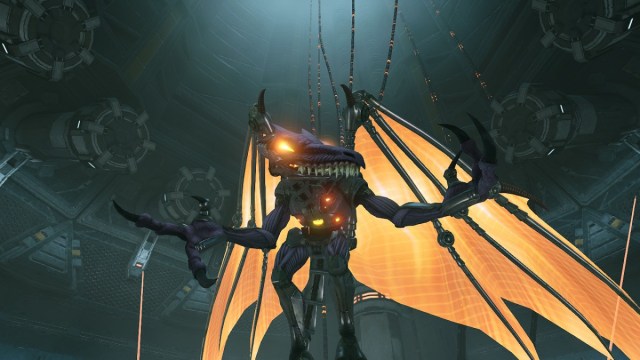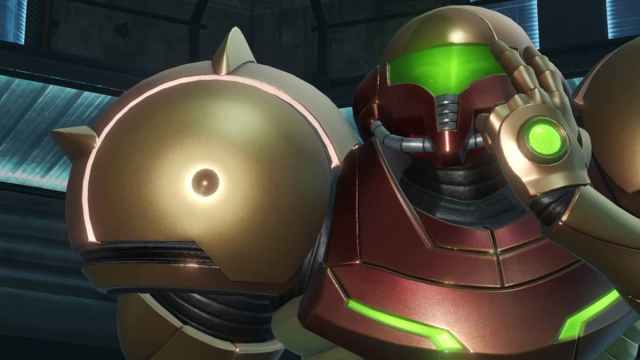Exploring and excavating
In some ways, Metroid has always been a series about the tension between discovery and destruction. Nearly every tool in Samus’ ever-growing arsenal serves two purposes: it helps her find something new, and it helps her tear it to shreds. Sometimes unearthing secrets is wrecking shop, as in the case of the series’ iconic-but-divisive destructible walls. But Metroid is most interested in finding the line between investigation and annihilation in Metroid Prime.
Most would agree that the most dramatic difference between Metroid Prime and earlier games is the jump to the third dimension. This opens the door for all kinds of structural shakeups, but my personal favorite is the Scan Visor. With the Scan Visor, Samus can learn details about nearly every element of her environment. And it changes things considerably.
What can’t you do?
I’ve long held that games are chiefly defined by their limitations. Every game is a set of restrictions, a series of things you aren’t allowed to do. In Metroid Prime, for example, you may scan enemies and you may shoot them. There are no other points of interaction between the player and the characters classified as “enemies.” You’re not going to sit down and reason out your differences with the Space Pirates. That’s just not the game you’re playing.

This is not an especially novel observation. While there’s something vaguely melancholic about studying a creature before you destroy it, Samus has always been a killer. The game knows this: using the Scan Visor is mechanically identical to locking onto enemies to shoot. What’s truly heartbreaking about Metroid Prime is the fact that Tallon IV once played host to creatures that Samus actually would talk with: the Chozo.
Scattered around Tallon IV are ancient Chozo writings that give players the best insight into the ancient race we’ve ever seen. We learn about their faith, their history, and their love for their new home. But it’s too late. By the time Samus lands on Tallon IV, the Chozo are dead and gone. Samus can lock onto their history. She can target it. But she can’t do anything else.
The surviving planet
Samus Aran is known for destroying, exploding, and otherwise incapacitating planets. She’s destroyed SR-388, ZDR, and even the planet where she was raised, Zebes. But she doesn’t destroy Tallon IV. In fact, after learning the planet’s history, studying its flora and fauna, and discovering the culture that once flourished there, she chooses to save it. She discovers that the planet has been awaiting a savior, and she becomes that savior.

But this doesn’t feel triumphant to me. All I can think is… what other planets needed saving? The Chozo occupied nearly every planet Samus has visited across the Metroid series. How many of those planets were awaiting a savior of their own? Was Samus meant to save Zebes from destruction? Most of those planets are Chozo graveyards, but so is Tallon IV — did the other Chozo want their graves protected and preserved? We’ll never know. The game won’t let us ask. Metroid Prime is not tragic simply because it’s a game about wandering through defiled graves. It’s tragic because it asks that the player consider all the other defiled graves they’ve wandered through.
A tragic fate
Metroid Prime takes place in between the first two Metroid games, which means Samus hasn’t started on her path of destruction just yet. But the player knows what’s bound to happen. They know that after the credits roll, whole cultures just like this one will be lost. We know bits and pieces of the history of ZDR, but we’ll never feel so close to it.

In Metroid Prime, Samus plays scholar and soldier. She catalogs every piece of Tallon IV, learns its secrets and becomes its savior. But as players, we know that we can’t keep this up forever. Someday, worlds will catch fire. Someday, we won’t have the luxury of stopping to take in an anthropological view. Scholar and soldier will, inevitably, become solely soldier. Discovery will lose ground to destruction. Samus will continue to occupy these spaces, and she’ll continue to learn their shape as they are, but it will forever be a means to a violent end.
Samus will always be a hero. That’s foundational to the character. She will never burn planets to the ground just for laughs. There’s always going to be a utilitarian trade-off to her decisions, and the Metroid games will always feel a little somber as a result. But Metroid Prime proposes a different, more thoughtful kind of Samus, one who examines her surroundings with a careful eye. That Samus cannot live forever.














Published: Feb 27, 2023 04:00 pm